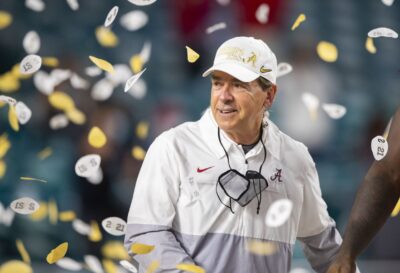
The spring practice period provides players with the opportunity to make an impression on the coaching staff and set themselves apart from teammates at a position.
Every year, there are expectations in place for certain players, and it’s up to that player to meet those expectations or not. Although coaches and teams seek to keep important information in the shadows, it’s not too difficult to determine which players have made a name for themselves or fallen short.
“We still have to improve a lot defensively. … It concerns me that we’re not able to stop the run at times when we’ve got a loaded box.”
– Kirby Smart
G-Day gave fans a glimpse of the team’s current makeup, but it was really just one piece of the spring practice puzzle. The second year in a player’s career is often looked at as the best chance for a breakout season. There is so much young talent on Georgia’s roster that those who follow the program can’t help but feel excited.
With summer upon us, it’s time to look back and evaluate the players who did the most to raise their stock this spring and those who were relatively disappointing.
Raised their stock
J.J. Holloman: Georgia had several priorities on the recruiting trail for the Class of 2017 and wide receiver was among the most pressing. Holloman was rated the No. 18 receiver prospect by the 247Sports Composite and was the top recruit at the position for the Bulldogs. As the only early enrollee at wide receiver this spring, Holloman had the chance to make a nice impression. He did just that.
“He’s one of the hardest workers out there with those mid-year guys,” Kirby Smart said at the beginning of spring practice. “He doesn’t really care what other people think. He doesn’t look around at the other guys. He’s focused on `I’m going to give you all the effort I can.’”
That effort manifested on G-Day, much to the delight of those watching. Holloman scored the game’s first touchdown and finished with three catches for 77 yards and the score. If he becomes a complementary piece in his first year, the receiving corps will benefit.
Mecole Hardman: It was a disappointment that Hardman, one of last year’s most enticing prospects, did not see the field in a meaningful way during his freshman season. That should change in Year 2.
Hardman is one of the most versatile athletes on the roster, and he’s being treated as such. The coaching staff worked him in the secondary, return game and at wide receiver. It’s the latter position where Hardman seems most likely to contribute. While not as shifty as Isaiah McKenzie, Hardman looks like he can handle the same type of role.
Jacob Eason: His relatively lackluster G-Day performance aside, Eason had the type of spring he needed. Smart constantly praised Eason’s growth as a leader and his improved understanding of the playbook, which was something he struggled with as a true freshman.
The presence of Jake Fromm, who also had a spectacular spring period, seems to have given Eason a true challenge at the position. Physical ability has never been a concern with Eason, but in-game consistency and an ability to understand the nuances of the game were lacking last year. Those qualities looked to be much improved this spring.
@FootballUGA QB @skinnyqb10 Threads Needle For TD To ?⚫ WR @Itslilstanley In '17 G-Day Game…Eason: 16-36, 311 Yds, 2 TDs
Vid: @SECNetwork pic.twitter.com/tMMsRcdTgO
— Hall Sports Communications (@Loyal_To_The_G) April 25, 2017
Others who improved stock: Terry Godwin, J.R. Reed, Deangelo Gibbs, Brian Herrien, Solomon Kindley, Lamont Gaillard, Tyrique McGhee, Jonathan Ledbetter
Lowered their stock
The defense: One of Smart’s favorite talking points this spring was that Georgia’s defense was not living up to its potential or his expectations. The unit returns 10 starters and is expected to be a team strength come the fall. Despite that, Smart stated several times during spring practice that the offense was outperforming the defense.
“We still have to improve a lot defensively,” Smart said after the team’s first scrimmage. “I don’t hide behind the fact that we’re not where we need to be. … It concerns me that we’re not able to stop the run at times when we’ve got a loaded box.”
It’s worth mentioning that the Bulldogs were without arguably their top two defensive players this spring in Trent Thompson and Roquan Smith. The duo combined for 151 tackles last season and were fundamental pieces for Smart and Mel Tucker. Regardless, there is plenty of talent on that side of the ball.
Now, it’s fair to assume that Smart was pulling out an old coaching technique and chastising a defense that is expected to be good while giving confidence to an offense that could use a boost. That’s not a bad method, but Smart didn’t have the type of late-spring reversal that usually accompanies such a tactic.
Riley Ridley: The second-year receiver should be one of the most exciting players to track this season, but this wasn’t the spring he wanted. That’s not due to his performance, though, but rather his inability to do much of anything as he recovered from an ankle injury.
His injury combined with the performance of some other players at the position will make it important for Ridley to rebound quickly over the summer. He’s expected to be a featured part of the receiving corps, but others gained ground on him this spring.







